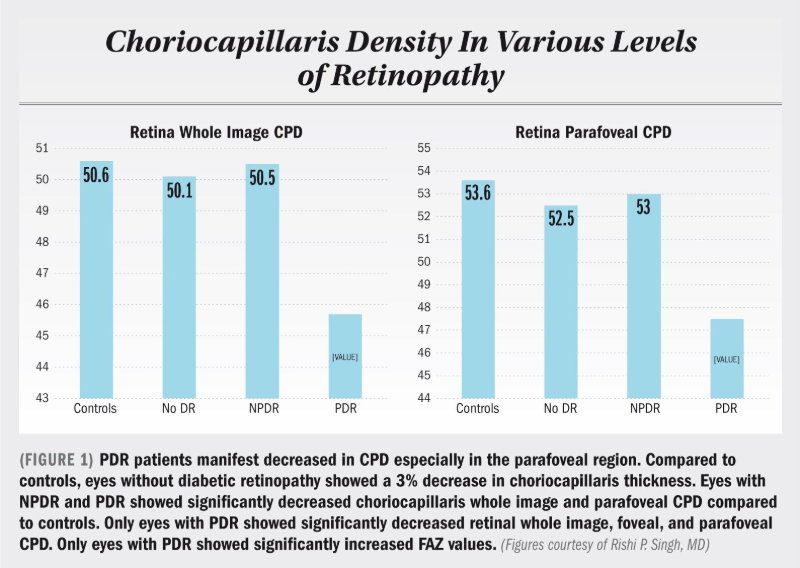
Diabetic Macular Edema
Latest News
CME Content




Compared with intravitreous ranibizumab, the decreases in the plasma-free VEGF levels were greater with intravitreous aflibercept and bevacizumab in patients with diabetic macular edema.

With the first ocular gene therapy approved in the United States, Szilard Kiss, MD, points out that the gene therapy era for retinal disease has arrived, “and hopefully it will arrive for age-related macular degeneration.”

Among a subset of patients in the phase IV PALADIN study, there was improved visual acuity, improved macular thickness, and reduced treatment burden among patients treated with the intravitreal fluocinolone acetonide 0.2 µg (Iluvien implant) for DME.

The addition of dexamethasone implant (Ozurdex, Allergan) to a continuing regimen of ranibizumab (Lucentis, Genentech) did not produce results in visual acuity outcomes that differed from those achieved with ranibizumab alone at 6 months. However, there was an improvement in the central macular thickness on OCT in patients.

The use of aflibercept led to greater improvement in macular perfusion status in a phase III trial with DME patients. Those with baseline nonperfusion tended to have more advanced disease.

There is subset of patients with resistant or persistent DME that forms the impetus for new treatment strategies, including next-generation anti-VEGF-A and new classes of drugs. Pravin U. Dugel, MD, outlines a list of potential treatment candidates that may lead that paradigm shift.


Results of the prospective TREX-DME study provide an evidence base for using a treat-and-extend protocol for administering anti-VEGF injections for eyes with diabetic macular edema.

Suprachoroidal triamcinolone acetonide (CLS-TA, Clearside Biomedical) injection resulted in visual and anatomic improvements in eyes with diabetic macular edema, particularly in those that were treatment-naïve. Multiple injections of the investigational treatment were well-tolerated and associated with a low incidence of IOP elevation.


Quantitative assessment of retinovascular features on ultra-widefield angiography images showed significant improvements in leakage and ischemia following treatment with aflibercept in patients with diabetic macular edema and retinal vein occlusion.

Development of technologies for sustained drug delivery is a topic of great interest among retina specialists considering the number of chronic conditions that are managed with repeated intravitreal injections.

The fluocinolone acetonide 0.2 mcg/day implant (Iluvien, Alimera Sciences) offers an additional option for treating diabetic macular edema that reduces the need for subsequent therapy with anti-vascular endothelial growth factor or steroid treatment.

The visual outcomes after anti-VEGF therapy administered to treat diabetic macular edema in the “real world” do not achieve those reported in randomized clinical trials. Eyes with better baseline visual acuity are disproportionately affected.

ALG-1001 is an integrin receptor inhibitor that acts to stabilize the retina’s response to diabetes-related hypoxic and oxidative stress, mitigating production of a host of molecules involved in the development of diabetic macular edema.

ALG-1001 (Luminate, Allegro Ophthalmics) has a number of different mechanisms of action that benefit patients chronically treated with anti-vascular endothelial growth factor drugs and those who are treatment naïve.

Patients with diabetic retinopathy have a high risk of developing macular edema after cataract surgery. Intravitreal injections of aflibercept might result in fewer patients developing macular edema in this patient population.

In the current era where pharmacologic therapy is the preferred treatment for macular edema secondary to retinal vein occlusion (RVO), there is still a role for laser, according to Francesco Bandello, MD.

Optical coherence tomography angiography (OCTA) is a promising new approach for visualizing retinal vascular pathology in eyes with diabetic eye disease that can be expected to have even greater utility in the future pending further enhancements.

The presence of vitreomacular adhesion (VMA) is associated with poorer, short-term anatomic, and functional outcomes in eyes with diabetic macular edema (DME) receiving anti-VEGF therapy, according to Márcio B. Nehemy, MD, PhD.

Findings from studies investigating intravitreal corticosteroids for treatment of diabetic macular edema (DME) provide information about their efficacy and safety, including some understanding of how they compare with anti-VEGF therapy.

Anti-vascular endothelial growth factor (VEGF) remains the gold standard therapy for diabetic retinopathy, but “when treating diabetic macular edema (DME), “about half of the patients treated with VEGF inhibitors do not respond to therapy,” said Tine Van Bergen, PhD, a scientist with ThromboGenics, Leuven, Belgium.













































